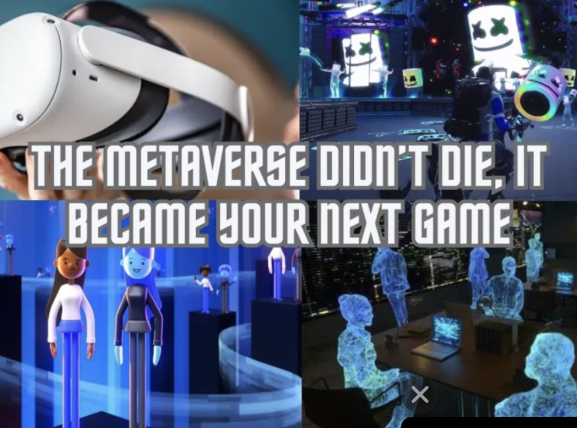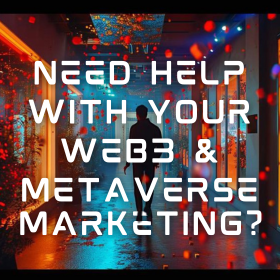Where Have All the Chief Metaverse Officers Gone?
The captains of industry that were going to pilot us through new virtual worlds are still around. They’re just going by a new name.
Last spring, At an event in New York City, Robert Triefus, then Gucci’s CEO of Vault—the brand’s virtual marketplace—argued the recent deflation in hype around the metaverse was just a brief hiccup. “I see it more as a correction,” he told the crowd. “We’re now at a much more sensible place, where you’ve got individuals [and] companies … who are very serious about what they’re doing.” When asked how buying real estate in The Sandbox aligned with Gucci’s broader goals as a brand, he responded with quasi-mystical language: “The metaverse is an opportunity to embrace the digital self.”
The following month, Triefus left Gucci “abruptly,” according to Vogue Business. He was off “to pursue other opportunities,” the brand said at the time. A month later, Vogue Business revealed that Triefus was to be the new Stone Island CEO. Immediately there was speculation on whether Stone Island would enter the metaverse. So far it has not.
Triefus’ public zeal for all things virtual and his short-lived tenure as the head of Gucci’s metaverse strategy are both part of a broader trend that briefly convulsed the private sector starting in late 2021: the hastily recruited “chief metaverse officer.” Following a wave of excitement around the metaverse as a golden new opportunity for commerce, a legion of brands rushed to launch their own virtual storefronts. Three quarters of CEOs surveyed by Russell Reynolds in 2022 said they were hiring dedicated talent to lead in the space, or expanding current roles to cover it.
While the actual titles varied, their main role seemed to involve helping their respective brands devise new strategies with then-buzzy technologies such as NFTs and crypto. However, the fact that there wasn’t much consensus around the definition of the metaverse only made for further inconsistency between job descriptions and what exactly these roles were meant to do.
Boom and Bust
This all started, of course, in October 2021, when Facebook changed its name to Meta, signaling its new focus on the metaverse. CEO Mark Zuckerberg painted a picture of a vast and hugely profitable virtual frontier, where future generations would work, play, hang out, date, and (crucially) shop. Reality Labs, the company’s virtual reality (VR) division, backed up that belief with cold hard cash, spending $13.7 billion in 2022 alone—a figure higher than the GDP of Mongolia.
Brands leapt at the opportunity to sell a whole new category of virtual goods and experiences, tantalized by the notion that consumers were lining up to attend VR concerts and buy NFT sneakers.
“Many brands were quick to experiment—there was a sense of a land grab,” says Matthew Ball, a tech investor and the author of The Metaverse. “They didn’t want to be last, and they were excited to try and be first … They also saw the opportunity to do something that is actually very unusual for a brand, which is to be part of a social experience.”
Luxury brands were particularly keen, having been slow on the uptake with the early days of ecommerce. It also felt like the perfect overlap, as the twin Web3 ethos of exclusivity and authenticity meshed nicely with their industry’s allure. And, for a moment, it seemed to be working.
Gucci, the first luxury brand to purchase digital real estate in the Sandbox, famously sold a virtual version of its Dionysus handbag on Roblox for about $4,100—$800 more than the price of its physical counterpart. Jeweler Tiffany & Co launched virtual necklaces modeled after the CryptoPunks NFT series (“NFTiffs”), which initially sold for around $50,000 apiece, earning the company more than $12 million. And Burberry launched a two-pronged attack, offering digital branded skins on Minecraft and a capsule collection inspired by the game in real life, netting an estimated £5.2 million ($6.8 million) return on investment in advertising.
Law firms even started setting up in the space—no doubt sparked by Hermès suing an NFT creator for selling 100 “MetaBirkin” NFTs based on the brand’s famous Birkin bag. Reflecting this wave of excitement, McKinsey published a report in April 2022 estimating that the metaverse would be valued at $5 trillion by 2030.
Then, as quickly as it had materialized, the excitement dissipated. Like Dorothy peering behind the curtain and finding the Wizard of Oz to be no more than a diminutive man pulling levers, the world seemed to have looked into the metaverse and found … not much at all.
Horizon Worlds—Meta’s flagship VR platform—was a virtual ghost town populated by legless virtual avatars. In late 2022, data aggregator DappRadar found that Decentraland—a virtual “sandbox” where users can buy and sell virtual real estate—had just 38 active users over a single 24-hour period. Let’s say that again: Just 38. The company’s market cap at the time was around $1.3 billion.
It was around that time that Meta—along with most other big players in Silicon Valley—pivoted much of its capital and PR muscle to AI in a panic, following the surprise release of ChatGPT in November 2022. Brands that not so long ago had thrown themselves wholeheartedly into the metaverse soon began to follow suit.
It would be surprising if it wasn’t all so incredibly familiar. Back in 2007, Second Life, an open-world online game in which users interact as pseudonymous avatars, was experiencing a period of explosive growth, grabbing the attention of companies who were keen to capitalize on it. With very little understanding of the platform, or knowledge of the users within it, companies including IBM, Cisco and Microsoft spent huge amounts on Second Life “islands” to have a presence in this bright new world. But by 2010, brands were already backing out, calling it a “costly mistake.”
Second Life founder Philip Rosedale says companies falsely believed that these virtual worlds would attract a representative sample of their target audiences, when current open-world online games like Fortnite and Roblox are being played overwhelmingly by kids.
"You don’t know if you can sell things to the people that are in a certain virtual world unless you can presume that they’re a cross-section of regular people," Rosedale says. “You need normal people that you’re selling stuff to, and that is what has absolutely, 100 percent not happened in Second Life or Horizon Worlds or VR Chat, or any of the other platforms.”
Ball adds that the speed at which brands wanted to act, without a real plan or understanding of the space, created issues for its longevity: “There was definitely a lot of, ‘We need to do this because everyone’s doing it,’ and ‘We need to do this because shareholders expect us to be doing it.’ There were many that overestimated the relevance of their brand in these 3D spaces.”
A Pivot to AI
Now, many of the chief metaverse officers, who had been so quickly installed, scrambled to reinvent themselves—or otherwise found themselves out of a job entirely. Coca-Cola’s Pratik Thakar swiftly pivoted from spearheading the brand’s metaverse content to becoming the company’s global generative AI lead in August 2023.
Around the same time, Michael White, who was tasked to lead Disney’s metaverse efforts in 2022, left after the brand’s dedicated metaverse division was closed down; the company announced it was launching a new AI “task force” just days later. Then, in the wake of Triefus’ departure from Gucci, the brand promoted a collaboration with Christie’s on its first generative AI project.
In case any further proof was needed that the shift from the metaverse to AI was complete, in the last quarter of 2022, Bloomberg transcript data recorded just two mentions of the metaverse in earnings calls at S&P 500 businesses. In the first quarter of 2023, AI had racked up 1,073.
According to Cathy Hackl, formerly the chief metaverse officer for a consulting firm called Journey, the broad-scale marketing shift from virtual brand experiences to AI was both a savvy business decision and just another example of technological bandwagon-jumping.
Today, Hackl reflects on the metaverse land grab as a phenomenon that quickly escalated out of control. “There was this rush among PR teams to get anything ‘metaverse’ out there,” she says. “I think we’ll look back at it as a really interesting moment in time, but maybe we all got ahead of our skis a little bit."
Don’t Mention the “M” Word
Even Hackl, who was given the nickname “Godmother of the Metaverse,” has been distancing herself from the concept, founding “a spatial computing and AI solutions company” earlier this year, with any mention of metaverse notable in its absence.
The metaverse-focused initiatives that once seemed to be a part of every launch are also suspiciously quiet. Bulgari, which launched an NFT jewelry collection on Polygon’s blockchain in 2022, confirmed to WIRED that it has no plans for any further collections in the future.
UNXD, a “curated NFT marketplace,” with partners including Dolce & Gabbana, Jacob & Co., and Valentino, is still advertising a competition for Metaverse Fashion Week 2023, along with a number of “to be announced” collections that had been confirmed for launch in 2022.
The buzz on collections that were initially successful has all but died too—Tiffany NFTiffs now sell for around $2,300 on NFT marketplace OpenSea, a drop of more than 95 percent from peak selling prices, while the activity on Gucci’s “Superplastic” NFT series on OpenSea shows a staggering drop in sales interest from around September 2022, and now—virtually nothing.
Why this has happened is up for debate. From the lack of an audience, to the clunky, uncomfortable, and prohibitively expensive VR hardware, or the lack of interoperability, the promise of the metaverse from 2021 simply isn’t holding true in 2024. And Zuckerberg knows it: He mentioned the word just three times in his hour-long keynote address at his company’s developer conference, Meta Connect—despite the fact it’s his company’s namesake.
Not everyone has given up on the idea, though. A quick scan of LinkedIn shows chief metaverse officers are, amazingly, still in place at some companies, though those job roles are now usually lumped in with any number of emerging digital innovations. Nelly Mensah at LVMH is one of them, with references to her job title subtly shifting to “VP of Digital Innovation” as interest in the metaverse wanes. In keeping with the trends of the industry, the most recent digital experience from the company leaned heavily on Generative AI, with no mention of the “m” word to be seen anywhere.
This fall from grace was anticipated by Matthew Ball in a footnote at the end of his book, predicting that by the time the underlying concept finally arrives, we’ll call it by a different name. And right on cue, augmented reality arrived to pick up where the metaverse left off.
Repositioning a Concept
With the VR-focused metaverse clearly not clicking with the mainstream, many tech brands have begun to lean into AR in the hope that sticks. So far, it’s looking promising. Meta unveiled its Smart Glasses in partnership with Ray-Ban last year, and it teased the first real prototype of its “true augmented reality glasses” at Meta Connect; Apple has made much of the Vision Pro’s ability to let the user toggle between pass-through AR and VR; Snap just released the latest iteration of its AI Spectacles in September, exclusively to AR Lens developers; and we’re all waiting to see the final version of Google’s new AR glasses it couldn’t help but tease back in May.
Meanwhile, “phygital” has cropped up as a new marketing buzzword, referring to a supposedly growing demand among consumers to blend physical and online experiences. So, with perhaps almost depressing inevitability, another LinkedIn search shows this phrase now increasingly appearing in job titles where once the M-word loomed large.
According to Shara Senderoff, founder of virtual design studio Futureverse, the tech world’s pivot to AR is an attempt to backpedal to a form of virtual experience that will be more palatable to the average consumer.
“We skipped a step,” she says. “We went from nothing to 6-lb [VR] headsets. That’s never going to be comfortable, literally and figuratively. Now you’re seeing Snapchat and Meta lighten the load to onboard people into an experience that’s more accessible.”
Perhaps finally realizing that, like the poor folks in Decentraland (and possibly Apple’s Vision Pro team), no one wants to live inside a computer, Zuckerberg seems to have performed a kind of marketing sleight-of-hand, repositioning the metaverse from a fully immersive, virtual experience to one that can be accessed through the company’s AR-powered smart glasses. An experience which he hopes that, unlike VR, will be a mainstream hit.
The company’s advances in AR, he said during the Meta Connect Keynote, “are getting closer to achieving the dream of Reality Labs … This is where we are going.” Then again, he’s invested far too much to be able to afford saying anything else.
Wired







